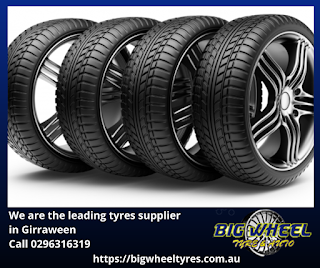Types of tyres available in Tyre shops Blacktown
Introduction:
A tyre is a tough, flexible rubber casing attached to the rim of a wheel. Tyre shops in Blacktown provide a non-slip surface for traction and act as cushions for the wheels of a moving vehicle. Tyres are used in cars, trucks, buses, aircraft landing gear, farm equipment such as tractors, industrial vehicles such as forklifts, and general transportation equipment such as strollers, shopping carts, wheelchairs, bicycles, and motorcycles.
Most vehicle tyres are pneumatic. The air inside the tyre is kept under pressure. Until recently, pneumatic tyres had a tube to hold the air pressure, but today's pneumatic tyres are designed to form a pressure seal with the rim of the wheel.
Uses of tyres:
There are different types of tyres designed for specific purposes. Tyre shops in Blacktown are used in the automobile field, and in fact, tyres are used in all cars, but the use differs depending on the type of vehicle. They can be differentiated according to load capacity and area of application. B. A car, plane or bicycle. Light to medium-duty tyres are used on trucks and vans to carry specific row loads but differ from light-duty tyres used on passenger cars on the drive wheels. High-performance tyres are also used on large trucks and buses. Some other speciality tyres are used for specific purposes such: as B. Winter tyres used on snow or High-performance tyres, all-season tyres all-terrain tyres, and mud-terrain tyres. Metal tyres are used for locomotives and railway vehicles. Solid rubber or other polymer tyres are used in a variety of non-automotive applications such: as B. Carts, caster lawn movers, and wheelbarrows.
Tyres for all types of vehicles are pneumatic, including cars, bicycles, motorcycles, buses, trucks, heavy equipment, and aeroplanes. Other heavy-duty non-automotive applications can be designed to use these tyres. Different industrial applications have different design requirements.
Tyre type:
There are different types of tyres that are suitable for different uses. Tyre shops in Blacktown can divide tyres into two categories. Tubes and tubeless tyres. The first version of the tyre was simply a metal band attached to a wooden wheel to prevent wear. Early rubber tyres were solid, not pneumatic. The most common and popular type of tyre on vehicles today is the pneumatic tyre, which is classified as a tubed tyre. These tyres are available in different grades, from flight-duty types to medium and heavy types.
However, it is designed to provide traction, resist wear and absorb surface irregularities. It is also designed with consideration given to ride comfort, noise, fuel consumption, and braking. A tubeless tyre is also a pneumatic tyre that does not require a separate tube. A semi-pneumatic tyre has a hollow core but is not pressurized. They are lightweight, inexpensive, puncture resistant and cushioned. Most often these tyres are equipped with ball bearings integrated with the wheels. Semi-pneumatic tyres are used in lawnmowers, wheelchairs and wheelbarrows. It can also be used for industrial applications.
Airless tyres are non-pneumatic tyres that are not assisted by air pressure. They are often used in compact vehicles such as golf carts and commercial vehicles with a high risk of failure such as construction machinery. Tyres used in industrial and commercial applications are non-pneumatic.
Solid tyres are used in lawnmowers, skateboards, golf carts, scooters and many other light industrial vehicles, carts and trailers. Solid rubber tyres are often used on material handling equipment such as forklifts.
Tyre performance characteristics
The tyre must meet the following performance criteria:
Dynamics:
Balance - Distributes mass evenly around the circumference to keep the tyre balanced during high-speed cornering. The manufacturer checked the tyres for excessive static and dynamic imbalance using an automatic wheel balancer.
Centrifugal Growth - Tyres increase in diameter due to centrifugal force at higher rotational speeds. This pushes the tread of his rubber off the axis of rotation.
Pneumatic Caster - A truck-like effect produced by rolling compliant tyres over a hard surface, such as when subjected to side loads such as corners.
Slip Angle or Side Slip Angle - The angle between the actual direction of travel of the rolling wheel and the direction it is pointing.
Relaxation Length - The delay from starting the slip angle to reaching the steady state value of the cornering force.
Spring Rate - The ratio of a tyre's vertical force to vertical deflection, contributing to the vehicle's overall suspension performance.
Stopping distances - Performance-oriented tyres typically have slightly shorter stopping distances because they have tread patterns and rubber compounds designed to grip the road surface.
Authority:
- False Thrust
- Circle of Force
- Adhesive plasters
- cornering force
- Dry traction
- Forced vibration
- Rolling resistance
- Torque restoration
- Wet traction.
Burden:
Load Sensitivity - How a tyre behaves under load
Workload – Monitor tyre workload to ensure tyres are not overstressed leading to premature failure.
Treadwear - caused by normal contact with the road or terrain. Poor wheel alignment can cause excessive wear on the innermost or outermost ribs. Gravel roads, rocky terrain, and another rough terrain can also accelerate wear.
Conclusion:
The most common use tyre of Tyre shops in Blacktown is for transportation purposes such as automobiles and bicycles. They are a pneumatically inflated structure that provides a flexible cushion that absorbs shock as the tyre rolls over rough surfaces. This is a circular component designed to transfer application loads through the wheel to the ground and provide traction to the surface the wheel travels over.
Disclaimer: This is a generic Information & post; content about the services can be changed from time to time as per your requirements and contract. To get the latest and updated information, contact us today or visit our website.

.png)

Comments
Post a Comment